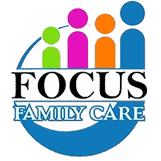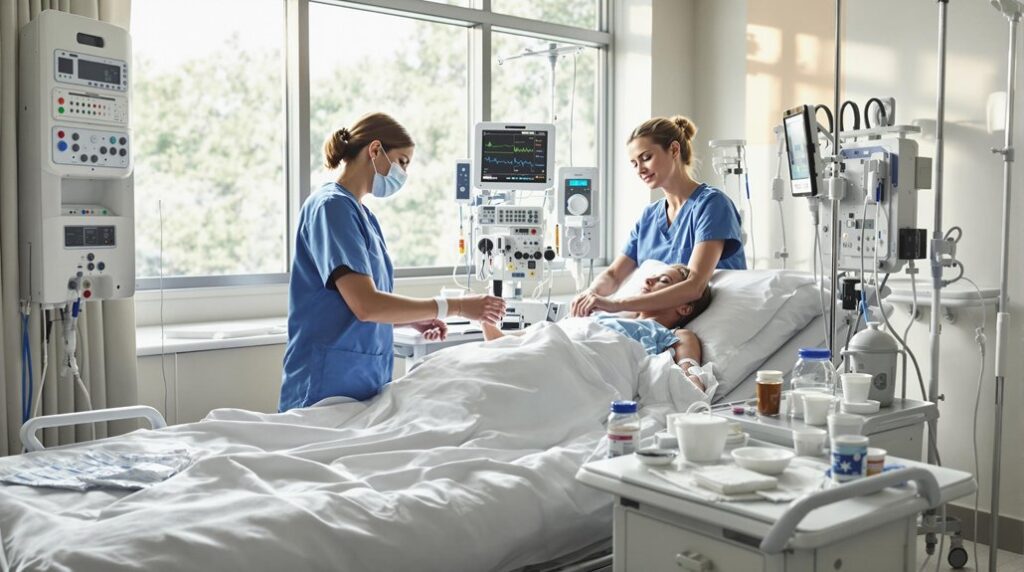Post-operative care starts as soon as you leave surgery, with medical staff monitoring your essential signs in the recovery room. You’ll receive personalized pain management plans, wound care instructions, and guidance on physical activity levels. Your healthcare team will track your temperature, blood pressure, and oxygen levels while teaching you proper hygiene practices to prevent infection. Regular follow-up appointments guarantee your recovery stays on track, with much more to explore about your healing journey.
Immediate Recovery Room Monitoring
After surgery, patients are transferred to the Post-Anesthesia Care Unit (PACU) where nurses closely monitor crucial signs and recovery progress.
PACU nurses serve as vigilant guardians during those critical post-surgery moments, tracking every vital sign and recovery milestone.
In this recovery room environment, you’ll find specialized monitoring equipment types that track critical signs, including heart rate, blood pressure, oxygen levels, and temperature.
As a healthcare provider, you’ll need to maintain constant vigilance over your patient’s breathing patterns, pain levels, and consciousness.
The PACU’s sophisticated monitoring systems will alert you to any concerning changes in your patient’s condition.
You’ll check surgical dressings for proper placement and drainage while managing pain medication delivery through IV lines.
You’ll document all observations and interventions in real-time, ensuring seamless communication with the healthcare team until your patient’s ready for transfer to their assigned unit.
Wound care and infection prevention requires careful attention to dressing changes and strict hygiene protocols to ensure optimal healing outcomes.
Pain Management and Medication Plans
When patients regain consciousness, effective pain management becomes a critical priority. Your healthcare team will develop a tailored medication plan that may include both opioid and non-opioid options. You’ll need to understand proper medication adherence to guarantee peak recovery and comfort.
- Your nurse will regularly assess your pain levels using a scale from 0-10 to adjust medications accordingly.
- You’ll receive detailed instructions about timing, dosage, and potential side effects of all prescribed medications.
- Opioid alternatives like NSAIDs, local anesthetics, or nerve blocks may be incorporated to reduce dependency risks.
- You’ll learn specific techniques to track your medication schedule and report any concerns to your healthcare team.
Remember to communicate openly about your pain levels and any medication-related issues with your care providers.
Skilled nursing care is available 24/7 to help monitor medication side effects and adjust comfort strategies as needed during your recovery.
Wound Care and Dressing Changes
Proper wound care works hand-in-hand with your pain management to guarantee ideal healing.
You’ll need to monitor your surgical site daily for signs of infection, including redness, swelling, or unusual discharge. Keep the area clean and dry, following your surgeon’s specific instructions for washing and dressing techniques.
Your medical team will demonstrate how to change dressings safely and effectively. During wound healing, you’ll need to maintain a sterile environment to prevent complications.
Always wash your hands thoroughly before and after touching the surgical site. If you notice any concerning changes, such as increased pain, fever, or separation of the wound edges, contact your healthcare provider immediately.
Some dressings may need to stay in place for several days, while others require daily changes based on your surgeon’s protocol.
Post-operative care typically requires 4-6 weeks for complete recovery and proper wound healing.
Vital Signs and Health Tracking
Monitoring your essential signs plays a critical role in post-operative recovery. By tracking crucial signs regularly, you’ll help healthcare providers detect potential complications early and guarantee your healing progresses smoothly.
Your medical team will teach you how to monitor and record these key health indicators:
- Temperature – Watch for fever, which could signal infection
- Blood pressure – Track readings to guarantee they remain within your target range
- Heart rate – Monitor pulse for irregularities or concerning changes
- Oxygen levels – Check saturation using a pulse oximeter if prescribed
Keep a detailed log of your crucial signs and health tracking measurements, noting any significant changes or concerns.
Don’t hesitate to contact your healthcare provider if readings fall outside the recommended ranges they’ve established for your recovery.
Skilled nursing care provides expert medical monitoring and support throughout your post-operative vital sign tracking journey.
Physical Activity and Movement Guidelines
Following surgery, you’ll need to carefully balance rest with movement to promote healing and prevent complications. Your healthcare team will provide specific guidelines about when and how to safely increase your activity level based on your procedure and recovery progress.
Start with basic movements like ankle pumps and gentle stretches while in bed. As approved by your doctor, progress to short walks using mobility aids if needed. Light exercise helps prevent blood clots, improves circulation, and maintains muscle strength.
Begin with gentle bed exercises, then gradually advance to brief walks. Even light movement promotes healing and prevents complications.
However, avoid lifting heavy objects or strenuous activities until cleared by your surgeon. Listen to your body and don’t push beyond your comfort level. If you experience increased pain, shortness of breath, or dizziness during movement, stop and rest.
Always follow your healthcare provider’s specific instructions about activity restrictions and recommended exercises.
After cataract surgery, proper eye protection must be maintained while engaging in any physical activities to prevent complications and ensure optimal healing.
Nutrition and Dietary Requirements
A well-balanced diet plays an essential role in your post-surgery recovery. Your body needs specific nutrients to heal properly and prevent complications. Focus on maintaining proper hydration balance and increasing your protein intake to support tissue repair.
- Consume 20-30 grams of protein at each meal through foods like lean meats, fish, eggs, or plant-based alternatives.
- Drink 8-10 glasses of water daily, unless your doctor specifies otherwise.
- Add fiber-rich foods gradually to prevent constipation, which is common after surgery.
- Include vitamin C and zinc-rich foods to promote wound healing and boost immune function.
If you’re having trouble eating solid foods, consider nutritional supplements recommended by your healthcare provider.
Follow any specific dietary restrictions provided by your surgical team, as some procedures may require temporary modifications to your eating habits.
Hygiene and Infection Prevention
Proper hygiene practices are critical to prevent post-surgical infections and promote ideal healing. You’ll need to follow strict infection control protocols to protect yourself or your loved one during recovery.
| Practice | Purpose |
|---|---|
| Hand washing | Prevents bacterial spread |
| Wound care | Maintains sterile environment |
| Clean bedding | Reduces infection risk |
| Personal hygiene | Promotes overall wellness |
Keep the incision site clean and dry, following your healthcare provider’s specific instructions. You’ll need to monitor for signs of infection, such as increased redness, warmth, swelling, or unusual drainage. Don’t hesitate to report these symptoms immediately. Change dressings as directed, always using sterile supplies and clean hands. Remember that proper hygiene practices extend beyond wound care to include regular bathing and maintaining a clean recovery environment.
Follow-up Appointments and Check-ups
Regular check-ups with your healthcare provider are essential for monitoring your recovery progress and preventing complications. During post-operative assessments, you’ll need to communicate openly about your healing process and any concerns you’re experiencing.
Your healthcare team will guide you through several important aspects of follow-up care:
- Physical examinations to check wound healing, range of motion, and overall recovery progress
- Review of your medication schedule, including adjustments or discontinuation of certain prescriptions
- Discussion of any symptoms, concerns, or complications you’ve noticed since your surgery
- Planning for future appointments and long-term recovery goals
Remember to maintain clear patient communication by keeping a log of questions or concerns between visits.
If you notice any unusual symptoms before your scheduled appointment, don’t hesitate to contact your healthcare provider immediately.
Home Care Instructions and Support
Once you’ve scheduled your follow-up appointments, successful recovery depends on following specific home care guidelines. Your home environment plays a vital role in your healing process, so it is important to prepare it properly. Having caregiver support can greatly improve your recovery experience.
| Task | Description |
|---|---|
| Environment Setup | Arrange furniture for easy movement, remove trip hazards |
| Daily Activities | Follow medication schedule, perform prescribed exercises |
| Support System | Coordinate with family/friends for assistance |
You’ll need to monitor your symptoms, maintain proper hygiene, and follow dietary restrictions. Keep emergency contact numbers readily available, including your healthcare provider’s information. Don’t hesitate to reach out if you experience unusual symptoms or have concerns about your recovery progress. Remember to pace yourself and avoid rushing back to normal activities before you’re cleared by your medical team.
Warning Signs and Emergency Response
Identifying critical warning signs after surgery can mean the difference between a smooth recovery and serious complications.
Being alert to post-surgery warning signs is crucial – it can determine whether your recovery is successful or takes a dangerous turn.
You’ll need to monitor specific symptoms and know when to seek immediate medical attention.
Watch for these warning signs that require emergency response:
- Severe pain that isn’t relieved by prescribed medication or pain that suddenly increases
- Fever above 101.5°F (38.6°C), chills, or excessive sweating
- Bright red bleeding that soaks through bandages or unusual drainage from the incision site
- Shortness of breath, chest pain, or sudden leg swelling
If you notice any of these symptoms, don’t wait – contact your healthcare provider immediately or call emergency services.
Quick action can prevent complications and guarantee your safety during recovery.
Conclusion
Post-operative care involves several important steps to help you heal safely and comfortably. Think of it as building a bridge to better health, one careful step at a time. Take your medications exactly as prescribed, keep your surgical site clean and protected, and be sure to attend all follow-up appointments with your doctor. Just like a garden needs daily care to bloom, your body needs consistent attention to heal properly.
Remember, you’re never alone on this recovery journey. Our caring team at Focus Family Care understands that healing takes time and support. We’re here to walk beside you every step of the way, ensuring you have the tools and guidance needed for a successful recovery.
If something doesn’t feel right or you have concerns, speaking up early can make all the difference. Your health and comfort are our top priorities.
If you or a loved one need help, don’t wait. Reach out to Focus Family Care today at (561) 693-1311 or email us at info@focusfamilycare.com.





